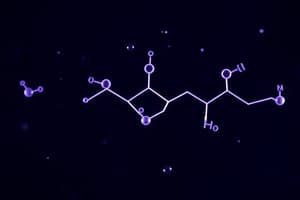Podcast
Questions and Answers
What is the characteristic peak range for the alcohol group (-OH)?
What is the characteristic peak range for the alcohol group (-OH)?
- 1620 - 1680 cm-1
- 1680 - 1750 cm-1
- 2500 - 3000 cm-1
- 3230 - 3550 cm-1 (correct)
Which functional group has a characteristic peak in the range of 1680 - 1750 cm-1?
Which functional group has a characteristic peak in the range of 1680 - 1750 cm-1?
- -OH Alcohol Group
- -OH Acid Group
- C=O Carbonyl Group (correct)
- C=C Unsaturated Group
What does the fingerprint region in an IR spectrum indicate?
What does the fingerprint region in an IR spectrum indicate?
- Simple structural similarities between molecules
- Unique variations that allow for molecular identification (correct)
- The presence of bonds only in organic compounds
- None of the above
How does the release of CFCs affect global warming?
How does the release of CFCs affect global warming?
What is the peak range for the unsaturated group (C=C)?
What is the peak range for the unsaturated group (C=C)?
What color change indicates the presence of primary or secondary alcohols when tested with acidified potassium dichromate?
What color change indicates the presence of primary or secondary alcohols when tested with acidified potassium dichromate?
Which reagent forms a silver mirror when an aldehyde is present during testing?
Which reagent forms a silver mirror when an aldehyde is present during testing?
What observation confirms the presence of an alkene when using bromine water?
What observation confirms the presence of an alkene when using bromine water?
What indicates the presence of a carboxylic acid during a reaction with sodium carbonate?
What indicates the presence of a carboxylic acid during a reaction with sodium carbonate?
Which statement about tertiary alcohols is true regarding potassium dichromate testing?
Which statement about tertiary alcohols is true regarding potassium dichromate testing?
What distinguishes high resolution mass spectrometry from traditional mass spectrometry?
What distinguishes high resolution mass spectrometry from traditional mass spectrometry?
In infrared spectroscopy, varying levels of absorbance of IR radiation are used to identify which of the following?
In infrared spectroscopy, varying levels of absorbance of IR radiation are used to identify which of the following?
What color change is observed in Fehling's solution when an aldehyde is present?
What color change is observed in Fehling's solution when an aldehyde is present?
Study Notes
Testing for Functional Groups
- Alcohols can be identified using acidified potassium dichromate - It turns from orange to green when reacted with 1° and 2° alcohols
- Aldehydes can be identified using Tollen's reagent - forms a silver mirror when warmed with an aldehyde
- Aldehydes can also be identified using Fehling's solution - forms a brick red precipitate when heated with an aldehyde
- Alkenes can be identified using bromine water - turns from orange-brown to colourless when reacted with an alkene
- Carboxylic acids react with sodium carbonate to produce carbon dioxide gas - CO2 can be identified by bubbling it through limewater, which will turn cloudy
Mass Spectrometry
- Used to identify compounds and determine molecular formulas
- High Resolution Mass Spectrometry is more sensitive and can determine the molecular mass to several decimal places
Infrared Spectroscopy
- Uses infrared radiation to determine functional groups present in organic compounds
- Different types of bonds absorb IR radiation in different amounts
- These varying amounts of absorbance are measured and recorded, allowing identification of certain bonds and functional groups
- Characteristic peaks in the IR spectrum correspond to specific functional groups:
- OH (alcohol group) - 3230 - 3550 cm-1
- OH (acid group) - 2500 - 3000 cm-1
- C=C (unsaturated group) - 1620 - 1680 cm-1
- C=O (carbonyl group) - 1680 - 1750 cm-1
- The fingerprint region of the IR spectrum contains tiny differences that allow for identification of specific molecules
- Global Warming - Infrared absorption by atmospheric molecules like ozone traps heat within the Earth's atmosphere
- CFCs released into the atmosphere enhance this heating effect, contributing to global warming.
Studying That Suits You
Use AI to generate personalized quizzes and flashcards to suit your learning preferences.
Related Documents
Description
This quiz tests your knowledge on identifying various functional groups and the analytical techniques used in chemistry. Topics include methods for detecting alcohols, aldehydes, alkenes, and more, along with mass spectrometry and infrared spectroscopy principles.



